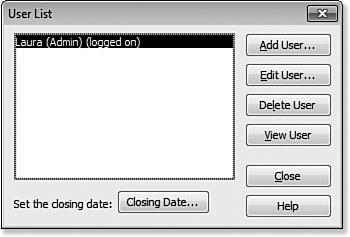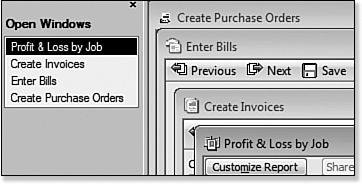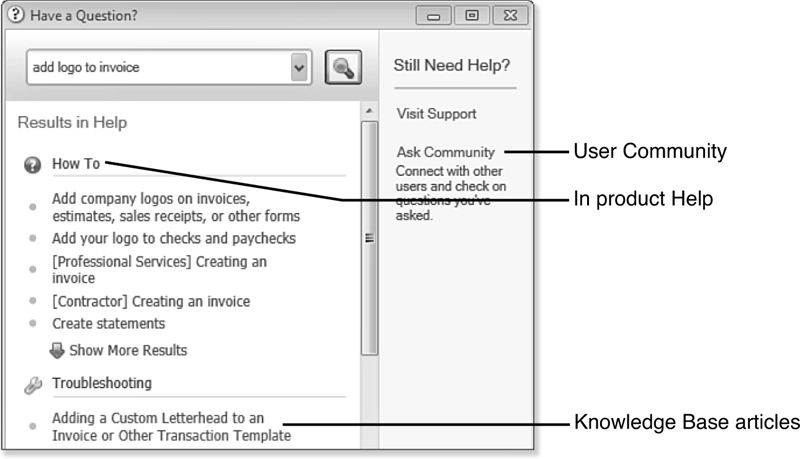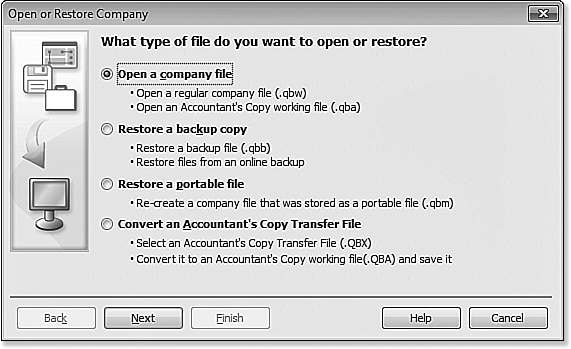2. Getting Around QuickBooks
Home Page and Navigation
You can make the most of your QuickBooks software when you learn how to navigate and customize the options available to meet your business’s specific needs. This chapter will show you just how easy that task can be. For example, if your business does not need to track inventory, you can turn off that feature. However, as your business grows and the products and services you offer change, you can later reenable the same features.
QuickBooks 2012 makes it even easier to customize and navigate this easy-to-use and very popular accounting software. Let’s start by making this your software!
Title Bar
At the top of your open QuickBooks file is the title bar as shown in Figure 2.1. The title bar indicates the following information about your file:
Figure 2.1. QuickBooks’ many navigation points make it easy to work with.
If you are following along this text using one of the sample data files installed with your QuickBooks file, take note of any customization you do. This customization in the sample file will not affect your own QuickBooks file.
• Name of your file as it is assigned in Company Name field in the Company Information dialog box (select Company, Company Information from the menu bar to open this dialog box).
• Your QuickBooks software year and edition; including Pro, Premier, or Enterprise. Also indicated (if applicable) is the industry specification such as accountant, retail, professional services, and so forth.
• Multi-user and the currently logged in username, if more than one user has access to the company file at a time.
Menu Bar
The menu bar includes nearly all of the tasks, reports, forms, and functionality available in QuickBooks. If you are a new QuickBooks user, I encourage you to review all the menus and submenus. Just look at what is included in the Company menu shown in Figure 2.2. Discovering these features can be valuable for your business as many of these additional QuickBooks tools are beyond the scope of this book.
Figure 2.2. Review the menus for useful tools and features not shown on the Home page or icon bar.
This book uses the menu bar when providing instructions for getting around QuickBooks. You might also want to access the same tasks from the customizable icon bar or Home page.
Icon Bar
The icon bar (see Figure 2.1) provides quick access to the tasks and reports you frequently use. You can customize the icon bar by adding or removing shortcuts and it is uniquely customizable for each user.
To customize the icon bar for a particular user, make sure you are logged in to the file with that username before making any changes.
![]() For more information about setting up users and permissions, see “Getting Started with QuickBooks,” p. 21.
For more information about setting up users and permissions, see “Getting Started with QuickBooks,” p. 21.
You can customize the icon bar by:
• Adding icons (shortcuts)
• Editing existing icons
• Rearranging the order of the icons
• Grouping icons
• Removing icons
Home Page
The best place to start customizing QuickBooks specifically for your business needs is on the Home page. The Home page displays by default when you create a new QuickBooks file and includes tasks and workflows you can customize (refer to Figure 2.1). You can add or remove icons from the Home page. You cannot rearrange the order or placement of icons on the Home page. (Some Home page icons cannot be removed if related preferences are enabled.)
Now that you know how to “drag and drop” a list item, you will be able to rearrange many other QuickBooks lists this way!
When you customize the Home page to include or remove specific icons, you are often redirected to the related preference. For more detailed instructions on working with individual preferences, see the “Preferences” section in this chapter or the related preference section included with most chapters in this book.
The Home page icons require you to be logged into the file as the Admin or External Accountant user (see Chapter 1).
Customizing Icons (Tasks)
The QuickBooks Home page displays common tasks and workflow for Vendors, Customers, Employees, and other activities and information. Some tasks can be added or removed depending on the needs of your business.
If your Home page did not automatically display, you can always open it by clicking the Home page icon on the icon bar as displayed in Figure 2.1. In this section, you will learn to manage the preference to display the Home page each time you launch QuickBooks.
If you want to make changes to the Home page icons, follow these steps:
1. First, log into your file as the default Admin or External Accountant user. Enter the appropriate password if one was set.
2. From the menu bar, select Edit, Preferences to open the Preferences dialog box, which displays the preferences available in your file.
3. Select the Desktop View preference in the left column.
4. Select the Company Preferences tab at the top of the Preferences dialog box. The following options are provided:
• Customers—Choose to add or remove the following Home page icons:
• Invoices—Can only be removed if Estimates, Sales Orders, and Sales Tax tracking is disabled. Either Sales Receipts or Statement and Statement Charges must be enabled to remove Invoices from the Home page.
• Sales Receipts
• Statements and Statement Charges
• Vendors—Option to remove both the Enter Bills and Pay Bills icons. If this option is grayed out, it is because another preference is enabled that is dependent on using vendor bills. For example if Inventory is enabled you cannot remove the vendor icons of Enter and Pay Bills.
• Related Preferences—Enable or disable features globally for all users. These preference settings will be discussed in more detail in their related chapters.
• Estimates—See Chapter 9.
• Sales Tax—See Chapter 9.
• Sales Orders—See Chapter 9.
• Inventory—See Chapter 5.
• Payroll—See Chapter 11.
• Time Tracking—See Chapter 11.
5. Click OK to close the Preferences dialog box.
Read the referenced chapter before adding a new Home page icon. Often other unique settings will need to be defined when adding a new icon to your Home page.
If you know you want to remove an icon (task) from the Home page by deselecting it in the Preferences dialog box, you can safely do that. These icons can later be reinstated to your Home page.
Customizing Lists Displayed on Home Page
The right side of the Home page (see Figure 2.5) displays several additional panels of information. Click the plus sign (+) to expand the details; click the minus sign (–) to collapse them.
Figure 2.5. Each panel of information can be expanded or collapsed.
These panels include:
• Getting Started—Click Quick Start Center for useful links and videos to help you get started with common tasks. Click Setup and Training for information on getting assistance from Intuit. Optionally, click the “x” in the top-right corner to remove this panel from your Home page. You can later reinstate it in on the My Preferences tab of the Preferences dialog box (select Edit, Preferences from the menu bar to open this dialog box).
• Account Balances—Click the column headers to sort the accounts by the Name or Balance column.
• Do More with QuickBooks—Links to other products or services offered for QuickBooks users.
• Backup Status—Notification of when the last backup was completed and links to information on storing your data online.
• Reminders and Alerts—Links to view the reminders and alerts you have enabled in your QuickBooks file.
Open Windows List
Are you ready for another personal preference for navigating in QuickBooks? Try the Open Windows list. With computer monitors getting larger and larger, you will most likely have plenty of room to use it with your QuickBooks file.
From the menu bar, select View, Open Window List. The Open Windows list displays on the left side of your Home page (see Figure 2.6), which enables you to move between many different open reports or forms easily by clicking on their name in this list.
Figure 2.6. The Open Windows list is useful when you have multiple windows open at the same time.
Your open windows might cascade one over the top of another open window. If you find this distracting, select View, One Window from the menu bar to make all of the windows use the full QuickBooks desktop area. You can also resize an open dialog box by dragging its top, bottom, sides, or corners.
Tutorials
In your QuickBooks software are several tutorials to help you get started quickly. You can watch these to supplement this In Depth guide to working with QuickBooks 2012.
To do so, select Help, Learning Center Tutorials from the menu bar. Click a category on the left or select quick links to What’s New to jumpstart your use of QuickBooks. When you are finished viewing the tutorials, click Go to QuickBooks to close the Learning Center.
Click any icon on the Home page (other than the Home icon) and see the Open Windows list on the left grow with each transaction or task that is opened. Would you like to close all open windows quickly? Select Window, Close All from the menu bar.
After closing all open windows, if you wish to return to the Home page, click the Home icon on the icon bar.
Preferences
You can customize QuickBooks to suit your specific business needs while maintaining individual preferences.
You are required to save your changes as you work with each preference. Some preferences might have you close all open windows to effect the change. Simply return to the Preferences dialog box until you are finished specifying all your preferences by selecting Edit, Preferences from the menu bar.
To return to the original preference setting, select a preference on the left side of the Preferences dialog box and click the Default button. Be aware the Default button is not available for all preferences. Click OK to close the Preferences dialog box.
Preferences come in two important types:
• Company Preferences—Affect all users of the currently opened QuickBooks file. Only the QuickBooks Admin and External Accountant user have full rights to set these preferences. Learn more about different types of users and user permissions in Chapter 1.
• My Preferences—Specific to the currently logged in user and do not affect the settings for other users of the same file or other QuickBooks files.
This section will provide a review of the most common, general use preferences. Most of the preference settings are self-explanatory and do not need to be discussed here. However, specific details on important preferences are provided in each chapter of this comprehensive guide.
Accounting—Company Preferences
These are global preferences and when modified will affect all users of the opened QuickBooks file:
• Date Warnings—A new file defaults to Warn if Transactions Are 90 day(s) in the Past and Warn if Transactions Are 30 day(s) in the Future (see Figure 2.7). At times, you might want to edit these date ranges, such as when you are just starting to use QuickBooks and need to enter data for a period in the past.
Figure 2.7. QuickBooks can warn when transaction dates do not fall within a specific date range.
Desktop View—My Preferences
These are personal preferences and, when modified, will only affect the currently logged in user:
• View—One Window or Multiple Windows per user preference. This preference also can be selected from the View menu on the menu bar.
• Desktop—Includes the following options:
To simplify your daily QuickBooks use, select the One Window option and select View, Open Window List from the menu bar.
• Save When Closing Company—Default setting that saves every open window when a QuickBooks session is closed. When QuickBooks is reopened, each report and form left open in the last session will be restored. This preference is not recommended for a file that has multiple users logging into the file simultaneously. Restoring multiple windows, forms, or reports at startup can slow down the time it takes for the QuickBooks file to open.
• Don’t Save the Desktop—Closes each open window automatically when the QuickBooks program is closed. This is the most efficient choice and will notify you if a transaction has not been completed before closing the form as well as give you the option to save any unmemorized custom report settings.
• Save Current Desktop—When you reopen QuickBooks, any previously opened non-transaction window will be displayed. Additionally, the preference to Keep Previously Saved Desktop will be automatically selected.
• Keep Previously Saved Desktop—Selected for you automatically. QuickBooks will open with all previously opened non-transaction forms and reports.
Certain preferences will override these defaults, particularly if you have selected the following preferences:
• Show Home Page When Opening a Company File—When selected, the Home page will always open when you launch QuickBooks.
• Show Getting Started Window—Useful if you are still setting up your file.
General—My Preferences
These are personal preferences and, when modified, will only affect the currently logged in user:
• Pressing Enter Moves Between Fields—When this is not selected you will use the Tab key to move between fields and the Enter key to save a transaction or activate a highlighted command.
If you wish to use the Enter key to move between fields (perhaps you have grown accustomed to using the Enter key in this way with other software) then place a checkmark in this preference.
If you selected the preference “Pressing Enter moves between fields” and you wish to save a transaction or activate a highlighted command, use the combination of Ctrl + Enter from your keyboard.
• Automatically Place a Decimal Point—When selected, displays .01 rather than 1.00 when you type the number “1” in QuickBooks.
• Bring Back All One Time Messages—If data entry mistakes have been ignored in the past, turning on this warning can call attention to possible mistakes in the future.
• Keep QuickBooks Running for Quick Startups—When selected, the QuickBooks software might open faster. This is the only preference that will also affect other data files.
Spelling—My Preferences
These are personal preferences and, when modified, will only affect the currently logged in user.
Options include being able to always check spelling or ignore specific words or word with numbers, Internet addresses, and so forth.
When enabled, the Description, Memo, Notes, and Message fields of the following forms are spell checked: invoices, estimates, sales receipts, credit memos, and purchase orders.
If you do not select the option to always check spelling, on certain forms you will be able to manually spell check.
Help Options
As a business owner or accounting professional new to QuickBooks, you will find there are many resources for getting the help you need. To access Help in QuickBooks you can press the F1 key on your keyboard, or choose Help, QuickBooks Help from the menu bar.
New for QuickBooks 2012 is the search tool on the right side of the icon bar. From the drop-down list on the icon bar search field, select Search Company File if you want to search through your lists or transactions, or Help if you want to search technical resources.
QuickBooks provides help in several distinct ways and allows you to search each with a single dialog box, as shown in Figure 2.8.
Figure 2.8. Search multiple help resources all at once.
Options include
• How To—Links to more detailed information; content is sensitive to the area of QuickBooks you currently have opened.
• Troubleshooting—Links to knowledge-base resources including tools, features, or articles addressing your specific search term.
• Community—Connect with other users and see if your question has already been answered.
Would you prefer to have a local QuickBooks experienced professional come to your place of business to help you get started quickly? If so, choose Help, Find a Local QuickBooks Expert from the menu bar. You will be asked for your ZIP code to help locate a list of QuickBooks Certified ProAdvisors in your area and fees may apply.
Selecting a Company File to Open
In general, you will not have any trouble opening your QuickBooks file because the software will automatically select your file each time you open QuickBooks. There are, however, several ways to open your QuickBooks data. Listed here are the most common.
Opening Your Data for the First Time
After creating your new file, it launches automatically when you open QuickBooks. However, if you are opening your data for the first time on a new computer you will need to follow these steps:
1. Launch your QuickBooks software by clicking the QuickBooks icon on your desktop.
2. From the menu bar, select File, Open or Restore Company.
3. In the Open or Restore Company dialog box, select the Open a Company File option button, as shown in Figure 2.9.
Figure 2.9. If you have moved your file to a new computer, select the Open a Company file option and browse to the location of the stored file.
![]() For more information about the other file actions shown in Figure 2.9, see p. 518.
For more information about the other file actions shown in Figure 2.9, see p. 518.
4. Click Next.
5. QuickBooks will default to the last known folder that a QuickBooks file was opened from or you can browse to locate where you stored the file. Select the file and click Open. If required, enter your username and password to open the file.
Chapter 16, “Sharing QuickBooks Data with Your Accountant,” discusses in more detail different file types and their purposes. The QuickBooks instruction of selecting File, Open will only open a file with the extension of .QBW.
Choosing from a List of Multiple Data Files
Chapter 1 introduced you to working with the QuickBooks sample data that installs automatically with your QuickBooks software. Using sample data can give you the freedom to practice what you learn and gain confidence in working with your software.
You also learned in Chapter 1 how to create your company’s QuickBooks file using a variety of different methods.
In this section, you will learn how to open a QuickBooks file from a list, which is especially useful if you have multiple data files or want to open the sample data again after working in your own file.
To choose from a list of multiple data files, follow these steps:
1. From the menu bar, select File, Open Previous Company. A list of previously opened files (up to a maximum of 20) displays, as shown in Figure 2.10.
Figure 2.10. Access previously opened QuickBooks files easily.
2. Select a file in the list to open it.
3. Enter your username and password, if required.
If you need to increase the number of files shown, from an opened QuickBooks file, select File, Open Previous Company, Set Number of Previous Companies from the menu bar. QuickBooks can display up to 20 different data files in this list. Enter the number you want to include in your list and click OK when finished.
In Chapter 1, you learned how to open and test with sample data and create your own file. In this chapter, you learned how to navigate the many features and tools found in QuickBooks. Let’s take a quick break from QuickBooks and discuss some basic accounting in the next chapter, Chapter 3, “Accounting 101.” I promise it will be worth your time and help you make better use of your QuickBooks file.










